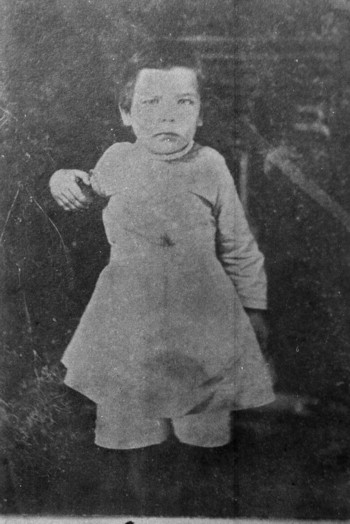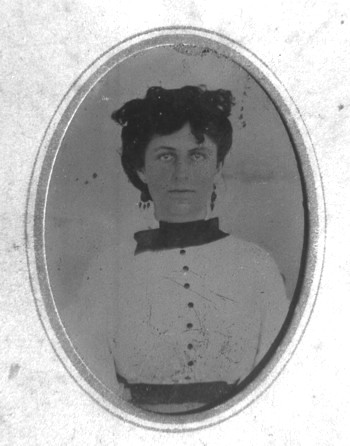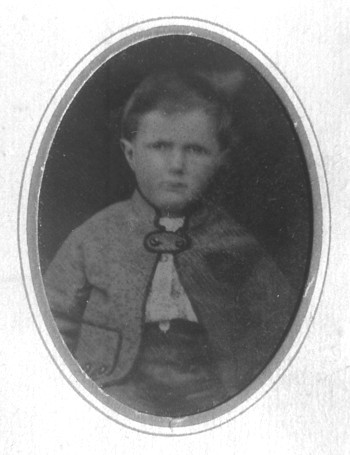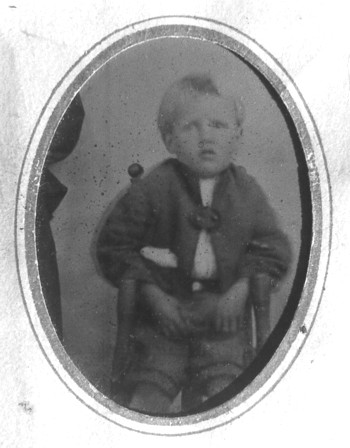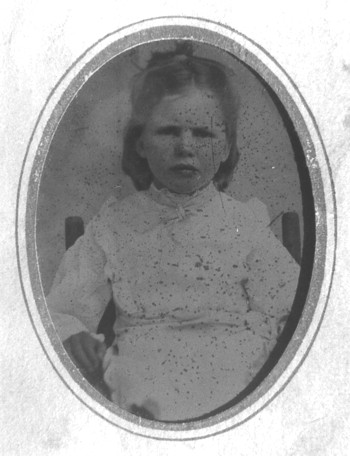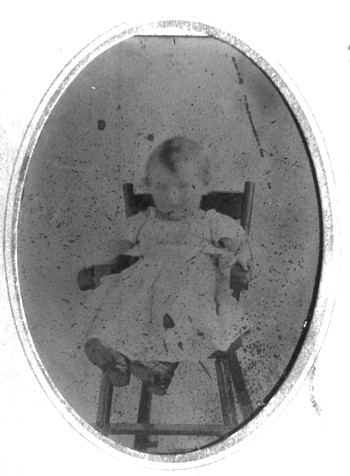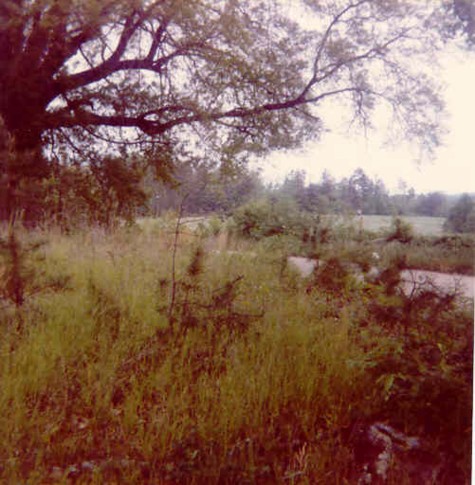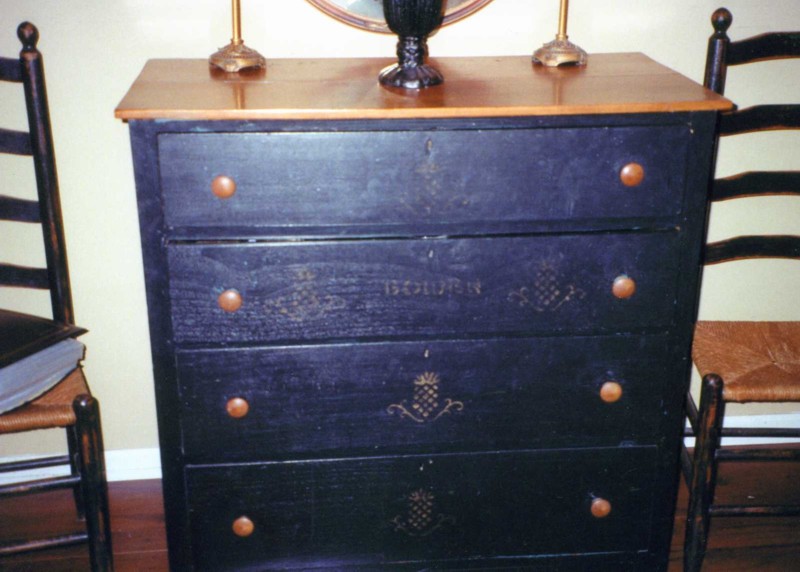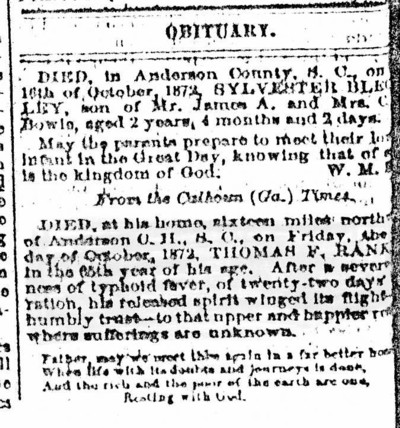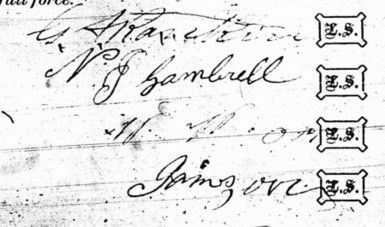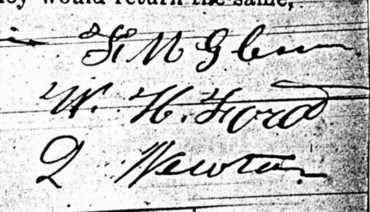Thomas and Sarah Rankin
Thomas Franklin Rankin
(1807-1872)
and Sarah Ann Orr (1815-1897)
Compiled and copyrighted June 2012 by Linda Sparks Starr
Thomas Frankin Rankin was born Friday 7 September 1807 in Pendleton
District, South Carolina. Others give his birthplace as near the
communities of Equality or Slabtown. As the eldest son of George and Mary Rankin, his place
in
the southern social order was guaranteed, or so it would seem. By
southern custom the eldest son inherited the bulk of his father’s
real estate holdings and the father’s social standing in the
local community. But these Rankins weren’t a typical Southern
family steeped in the cavalier tradition. Only two or three generations
removed from their Scots-Irish emigrants, they believed in individual
initiative and education. Thus the family business, Rankin Mills on
Twenty-Three Mile Creek, passed not to the eldest son, but to a younger
son whose personality and interests better fit that of a
millwright. In the days before the automobile, Thomas’s
occupation was listed as a mechanic. Today we might call him an artisan
or craftsman for he made furniture, of which this is an example:.
Some of his pieces are now
treasured heirlooms in the home of a descendant of his brother.
But he also made workday items like molasses mills and cattle feeding
troughs. However, the bulk of his labor seems to have been mending
wagons, farm machinery and mills. Logically we assume he kept the
Rankin mills turning.
Sarah Ann Orr, born 29 November 1815 in Pendleton District, was the
eldest child of her parents, and a member of the first generation born
in the United States on her father’s side. Little is known of her
mother, and thus Sarah’s childhood is difficult to envision. Thomas Orr appears to have had
continuing connections to the mercantile or banking trades. Since he
had cash to lend during the conflict, we can logically presume the
family was economically comfortable during Sarah Ann’s
childhood. But whether Thomas allowed his family the extra frills
he could afford, or whether all profits returned to his business, is an
unexplored subject.
Their marriage 19 May 1840 was probably viewed as the joining of the
Rankin Mills with the Orr mercantile businesses. By all accounts
the new Mr. and Mrs. Thomas F. Rankin had a promising future.
Sarah at twenty-five seems a bit older than usual for a first time
bride. Thomas F. was thirty-three, but as we’ve seen, Rankin men
tended to marry later in life. The future millwright, George W., was 37
when he tied the knot in 1860.
The couple's daughter Josephine was born only eleven months after the
wedding; she was followed quickly by two boys, William Robertson and
George Alexander. One hopes that Sarah Ann had some assistance
with the household chores and childcare. After four years of marriage,
she was the mother of three children. A second daughter, Mary,
arrived in 1846 followed by two more sons: Wilson Newberg and James
Crawford. Six children in the first eleven years of marriage
wasn’t unexpected, but it stressed both the mother and the
family’s cash reserves. These pictures (tintypes in some
cases) are thought to be pictures of these RANKIN children, but some
may be
RAMSAYs instead.
Although the total was only $10.89 ¼, the first unpaid-in-1872-loan signed by
Thomas F. Rankin is dated January 1852 . The note was made out to W. S.
& T. P Williams, which is thought to be a general merchandise store
located in nearby Pickens County. Printed forms indicate the name later
changed to W. S. & G. F. Williams and give Salubrity, S. C. as the
address. The running tab for Thomas F. Rankin grew annually.
Josephine Rankin died the summer of 1852, probably from one of the
numerous summertime illnesses that went through southern
families. She was buried in the oldest Rankin family cemetery.
Sarah Ann was pregnant at the time. The baby, born January 1853 and
named for his father, died just three months later. He was buried
near his sister. One can easily imagine the state of Sarah
Ann’s health that spring of 1853. For sure she was
depressed and exhausted. Thus we can logically assume she was
also sleep deprived and probably malnourished due to lack of
appetite. This isn’t a good combination for the mother of
five energetic children under twelve years of age. With this in mind,
we turn to
the trust fund her father set up for her that summer.
Thomas Orr was in his early seventies the summer of 1853 when he placed $1500
into the hands of his son, John B., and trusted friend, Thomas H.
McCann. He bid them to choose investments that provided the most
money. [LSS note: 1853 comes from statement “twenty Eight
day of July last.” ] Sarah Ann was to use the interest from
the investment for her sole benefit. The trust officially came
into being June 1854, but if the dates in the 1871 trust accounting
record are correct, she received a payment of $25 and $5 in January
1854; $35 in June and $17 in November 1854. However, the order of
the payments as
listed suggests the November payment was made in 1853.
Sarah Ann was 39 years old and Thomas 47 when their last child,
Margaret Ann, was born in August 1854. Less than two weeks later
Col. George Rankin died. In the division of Col. George’s
property, Thomas received
105 acres on the bank of McMurray’s Creek, a branch of Three
& Twenty Mile Creek.
Photo by Alice Starr of land where
Thomas F. and Sarah A. Rankin resided.
Perhaps influenced by Thomas Orr who felt Sarah Ann needed even more
help than before, the trustees
invested almost half the trust fund in an enslaved woman named
Sarah. Then, three months later, they invested the rest of the fund in
a “negroe woman and her two
children: 'Sooky, Nelly and Nancy, the youngest'.”
These were turned over to Sarah Ann as were two cash payments in
January and the last two fund payments in March 1855.
In 1856 Thomas F. Rankin paid his taxes along with other of his family
members: Mrs. Mary Rankin (his mother), his single sisters
and his brother Col. G. W. [Alexander, Morse &
Willie] In January Thomas added $96.86 ¼ to
his running tab at the Williams store. Two more notes were added to
this account in February 1857: $68.41 ¼ and then two weeks
later, $7.00 for a barrel of flour. This was the only one of his
store purchases specifically identified. What a treasure trove an
itemized accounting of his receipts would be! His purchases in
1858 were twenty dollars higher than in 1857, but he added a whopping
$133.92 to the store tab in 1859. Had the talk of secessionism
raised the inflation rate that much?
One of the larger loans Sarah Ann received from her father is dated 14
November 1859. Although there is nothing in the record explaining
her need for $168, the date is very close to that of a letter written
by T. S. Kennedy 18 November.
As head of Thalian Academy, Kennedy attested the good
moral character and gentlemanly deportment of Sarah Ann’s eldest
son, William Robertson Rankin. He ended the letter with a listing
of the courses W. R. had completed. W. R. was a sophomore at
Centre College in Danville, Kentucky in January 1861. Thus, it is
reasonable to guess part of this loan went towards W. R.’s
education.
By 1860 war clouds were swirling; perhaps discussions of the future
conflict had an impact on trustee John B. Orr’s decision to make
some changes. Or perhaps it was just the fact this tract became
available at this time. Orr devised a $1200 trade with Jobery
McMurray: most of the trust fund negroes (unnamed) for McMurray’s
212 acres. One slave remained with Sarah Ann – Ellen or
Nelly. Quoting John B.: “Mrs.
S. A. Rankin had the use of her till she was freed by the result
of the war. And also the full and free use of the land from the time it
was bought until it was sold in December 1871 to two of her sons,
George A. and James C. Rankin for $1350.”
Young men aren’t known for rational thinking, especially when
they fear they will miss all the excitement. In November the South
Carolina legislature called for a convention to consider secession. On
December 20, 1860 that convention unanimously approved an
ordinance of secession; the first state to do so. W. R. returned
home from college in Danville months before being mustered in to
his Confederate Army unit. His
official college withdrawal statement,
attesting he “was a member in
good standing of the
sophomore class ...” is dated 12 January 1861. The
timing of this letter raises the question of the $20 loan Sarah Ann
obtained from her father January 18; was this W. R.’s train fare
home? Sarah received a second $20 from her father in April. The timing
of that loan suggests she used it for items to send to the front with
her two soldier boys. W. R. joined Hampton’s Legion and
George A. the Palmetto Sharpshooters. Thomas and Sarah Ann’s
household was now reduced to only four children. But the number of
relatives who might need their assistance increased. Thomas F. at 53
didn’t join the army; but his 39 years old brother did.
George W. left behind his bride of only a few months; she was young
enough to be Sarah Ann’s daughter if my birth year for her is
correct. His aging mother and four single sisters, residing
together in the same household, likely considered themselves
self-sufficient. They might resent the implication they needed
“looking after,” but aging houses always need repairs. The
bigger question in all this is, who managed the Rankin Mills during
George W.’s absence?
During fighting around Seven Pines and Frasiers Farm in Virginia May
1862, Lt. George Alexander Rankin was wounded. He was furloughed
for 30 days in September and resigned later that year. [Starr p.
97; 98] Although they worried constantly about relatives near the front
lines, life on the home front went on and understandably financial
problems grew worse as the conflict continued. Thomas F. signed his last note to the Williams
store in March 1862.
Sarah Ann’s brother, James Orr, was having his own cash-flow
problems. Beginning in 1862 Thomas made and repaired several
items for James for which he wasn’t paid. The most expensive
single item was a corner cupboard at $10. Other household items
included a bedstead and scanthing for the bedstead. Repairs to
the thrashing machine (twice) and additions and repairs to the wagon
plus items for the barn completed the list. Sadly, the last item was
the coffin Thomas made for James’s wife, Sallie, in 1872. The total bill came
to
$37.25. Thomas also made beautiful pieces for his brother, George
W. Rankin (1822-1873). Descendants who enjoy using some of these
items in their own homes have generously shared these photos:
1863 was a better year for the Rankin family in many ways. Thomas
was able to make two payments on his original December 1860 note to
David Watkins. Although an historical reference wasn’t
found to corroborate this, there appears to have been an increase in
the use of molasses at this time. Thomas made a molasses mill for both
William S. Williams and James W. Earle in 1863 and then in 1864 he
either made another mill for Earle or repaired the previous one.
Neither was able to pay.
Sarah Ann began the New Year of 1864 by obtaining another $100 loan
from her father. One might presume this was for items Thomas routinely
charged this time each year at the Williams store. That November Thomas
signed a $137.81 note to J. M. Smith. He received a $25 credit on
this note in January 1868 by making a close press for the Smiths and $8
credit in October 1870 for making a secretary. The two men formed
an enterprise of some nature, called J
M Smith & Rankin, against which Thomas F. borrowed $7.15 in
May 1870. Sadly, the administrator of Thomas Rankin’s estate
submitted a bill to the estate of J. M. Smith for $8 “To getting coffin made of walnut
plank for his son, James Smith.” To her
credit, the last item microfilmed of Thomas F. Rankin’s estate
papers is a
request from Sarah Ann to the probate judge: [to give]
“the amount in his hands due her from the estate” to
J. M. Smith instead.
With much relief the family welcomed home William Robertson and his
Uncle George W. Rankin in 1865. No doubt they walked all the way home
from Appomattox. When the end came, both were serving with the South
Carolina Palmetto Sharpshooters. Sarah Ann asked her father for
another $64 loan in August. This was the last money she received
from him in his lifetime, or at least the last transaction he
recorded. Sarah’s mother died in 1864 or 1865 and Thomas Orr
died in 1866.
Where moving wooden mechanisms are concerned, it doesn’t take
long for minor problems to turn into major repairs. George W.
Rankin had been away from the mills for four years and major work was
needed. The administrator of Thomas F.’s estate submitted a
bill to
the estate of George W. Rankin for $91.65.
The receipt shows this consisted mostly of unpaid mill repairs dating
back to 1866. Against that backdrop is the bill, submitted
by the
administrator of George W. Rankin’s estate, of an unpaid loan to
Thomas dating back to January 1866. Before his death Thomas managed to
repay only $60 of the original $348.44 loan to his brother. The
date of this loan coincides with the timing of those annual treks to
the Williams store. Is this a reflection of the current rate of
inflation? In 1866 Thomas’s name is among the Anderson
District residents recommended to receive State Aid in the form of
revision of bills and payment of debts in installments. [Eades
reporting internet find Series #S165010, Item 11] Thomas began 1867 by signing a note to
his brother-in-law, Alexander Orr, for $140. This was listed
among the unpaid estate debts in 1876. To Alexander’s
credit, he only owed
Thomas Rankin’s estate $6.25 for three tables: a long walnut
table; a pine table and a third table.
1867 was a momentous year for their two soldier-sons. W. R.
Rankin, who had moved to Calhoun, Georgia by early 1867, returned in
July to marry Margaret Jane Ramsay. George Alexander Rankin
married Desdamona Gambrell in October. Sarah Ann learned in 1868 that
she was excluded from receiving anything more from her father’s
estate. This came as no surprise for that was the terms stated in the
1854 trust. The surprise was the 1869 agreement between her siblings to
toss out all her notes due their father’s estate. The year
1869 ended with the marriage in November of their son James Crawford
Rankin to Cornelia Mullikin. The remaining son, Wilson Newberg,
married Esther L. Martin sometime in 1870. These Rankin boys certainly
didn’t wait until they were in their thirties to marry.
Late in 1871 Sarah made a formal
request
to change the trustees of her fund from her brother, John B. Orr, to
her sons, George A. and James C. Rankin. The boys, with
young families of their own to think about, must have wanted assurance
improvements they made on the 212 acres wouldn’t disappear if the
trustees decided to sell. Rather than change trustees at this
time, it was decided the
sons would purchase the
land for $1350.
Even though, or perhaps because, it was all in the family, the
conservative trustees insisted upon a Surety bond of Twenty Seven
Hundred Dollars, or twice the selling price for the land. All surety bonds have
conditional clauses, and this clause was the receipt of two equal
payments with interest. The accompanying Mortgage Bond finalized the
deal.
Life comes with joy. In January 1872 their daughter Mary M. married
David W. Blassingame; then in November their youngest daughter,
Margaret Ann, married his brother, Addison H. But life also comes
with sorrow: Thomas Franklin Rankin died Friday, 4 October 1872.
According to his Victorian era obituary, published in the 31
October 1872 issue of the Anderson
Intelligencer, he suffered twenty-days from the effects of
typhoid fever. He was buried in the oldest Rankin cemetery near
his father, two children and siblings who had preceded him in death.
In those days doctors made house calls; two were called in by the
family. Dr. S. W. Clayton billed the family $22 for three visits,
including mileage and medicine. The bill from Dr. George E.
Robinson was only $16.25 even though he made 13 visits. He
charged for medicines but not his mileage. George A. Rankin
appears to have followed in his father’s trade for he billed the estate $22.88 ½
for making the coffin and providing the burial clothes.
Sarah Ann applied for Letters
of Administration on the estate of Thomas F. Rankin in November
1872. She estimated the value of his real estate at less than one
thousand dollars and his personal estate at less than five
hundred. Already anticipating the coming land sale, she also
requested that her homestead (dower) be laid off. George A.
Rankin was appointed
the administrator 5 December 1872 and those
signing the Six Hundred Dollars surety bond with him were his uncles
Alexander and James Orr and one of his wife’s kinfolk, N. J.
Gambrell.
Although five appraisers were appointed, only three or four were
expected to serve: James Orr, W. N. Ford, F. M. Glenn, Thos. A. Russell
Esq and Stephen Martin.
Sarah’s estimate of the value of Thomas’s personal estate
was close to the appraised
value: $278.50.
Early in January 1874 Sarah Ann again requested that her brother, John
B. Orr, and Thomas H. McCann be removed as trustees. This time she
suggested her son, W. N. Rankin, be appointed in their stead. W.
N. added his agreement to this action. The same time the trustees
entered into the record an
accounting (history) of the trust up to 1871.
Changes in trusts require legal oversight. This was especially true of
changes to this particular trust at this time. Understandably those
owed money by the estate of Thomas F. Rankin deceased fully expected
this tract, or part of it, would be sold to pay his debts. After
all, Thomas had full use of the land from the time it was purchased
until his death. An agreement to the
change of trustees was signed March 1875 by Sarah Ann, her
three sons who resided in South Carolina, and her brother John B.
Orr. Wilson N. was duly appointed the new trustee and filed trust
accounting records
accordingly.
By the summer of 1874 all the estate money that could be located had
come into the hands of the administrator; the payment of debts stopped
when the money ran out. The holder of some of the
longest-outstanding notes, the one person without a known family
or long-standing friendship tie to the family, brought a suit in the
Court of Common Pleas. As “W.
S. Williams, Survivor, plaintiff” he sued the
individual family members instead of the estate. Perhaps this was the
only way to force them to sell the real and personal property.
The best thing, genealogically, about this suit is the documented
listing of the names of the six surviving children: Geo. A.
Rankin, Mary An Blassingame, Margaret A. Blassingame (minor), James C.
Rankin, Wm R. Rankin. Wilson N. Rankin was omitted from the
original list.
The wheels of justice turn slowly; Williams had to wait until the end
of the year to rightfully win his case. In December the Probate
Judge appointed men to: “fairly
justly and impartially ... admeasure and mete out to Mrs. Sarah Rankin,
widow of Thomas F. Rankin deceased, and put her in full and peaceable
possession of one third part of a certain tract “the
residue of the Tract of land (after allowing the dower as set off
by the Commissioners) to wit all that Lot or parcel of land situate on
the waters of Three and twenty mile creek and adjoining lands of G A
Rankin, J. C. Rankin et al, it being the Same whereof the late Thomas
Rankin died Seized and possessed be sold by Wm McGukin Sheriff of
Anderson County on Salesday in January next.”of land .... on McMurays branch, waters of
Twenty three mile creek adjoining lands of the Estate of George W.
Rankin, Martha Rankin and Eliza Rankin and others and containing One
hundred and five acres more or less of which land the said Thomas F.
Rankin died legally seized and possessed.”
This was the land Thomas F. had received in the division of his
father’s property. .
The sale day
was the first Monday in January 1875 and Wilson N. Rankin was
the
highest bidder at $725. His
brothers signed the surety bond with him. Son Signatures
For now Thomas F.’s land remained in the family. His personal property (carpentry tools) was
sold 30 January 1875.
The last major hurdle for those dealing with the estate of Thomas F.
Rankin came October 1876. Sarah Ann Rankin and John B. Orr were
questioned about items mentioned in the original appraisal of the
estate; these items were not included in the estate sale because they
were purchased with trust fund monies. The judge was finally satisfied
there was no more money or goods to pay the outstanding debts. Sarah made one final request.
It was now left to the Judge to distribute the final proceeds and
his
worksheet is all we have. It is not known who received how
much in the final distribution.
Sarah Ann (Orr) Rankin died 13 June 1897 and is buried next to her
husband in the oldest Rankin Cemeter in Anderson County.
.
Not everyone gets their name in history books. Sometimes the best thing
to be said for an individual comes from the actions of their adult
children. Descendants of Thomas and Sarah Ann “did good” by
anyone’s standards.
Children from the Blassingame transcription of
the family
Bible:
1. Josephine Rankin born April 16th 1841 died
24 June 1852 (ts)
2. William Robertson Rankin born
December 18th
1842
3. George
Alexander Rankin born August 14th 1844
4. Mary Matilda Rankin born
November 4th 1846
5. Wilson Newberg Rankin
born December 12th 1848
6. James Crawford
Rankin born February 25th 1851
7. Thomas F. Rankin Jr. born January 31, 1853
died 27 March 1853 (ts)
8. Margaret Ann Rankin born
August 11th 1854
SOURCES
Alexander, Virginia; Elliott, Colleen Morse; and Willie, Betty,
compilers. Pendleton District
and Anderson County, SC Wills, Estate, Inventories, Tax Returns and
census Records. 1980.
Blassingame, Margaret (Rankin) transcriber. Family entry in a
Bible from copy given to Helen (Starr) Wade by a Blassingame cousin;
found in Helen’s papers passed on to LSS.
County records courtesy of the South Carolina Department of Archives
and History.
Eades, Barbara, descendant and researcher.
Jones, Ann Norton, descendant of William Robertson Rankin, whose house
and everything in it including his family papers and pictures
eventually fell to her grandmother, his daughter, Mary Belle (Rankin)
Norton. She generously shared family data, pictures and traditions with
this compiler.
Starr, Linda Sparks, author. W. R.
Rankin: Manassas to Appomattox 1991 Includes
transcription of W. R.’s diary and lists he compiled about army
companies connected with the Palmetto Sharpshooters.
Home: http://homepages.rootsweb.ancestry.com/~lksstarr/
Linda Sparks Starr copyright (c) 2010


